Fundamentals - Final Exam Review PDF

| Title | Fundamentals - Final Exam Review |
|---|---|
| Author | Gabby Palmeri |
| Course | Fundamentals of Nursing |
| Institution | Adelphi University |
| Pages | 56 |
| File Size | 851.2 KB |
| File Type | |
| Total Downloads | 104 |
| Total Views | 149 |
Summary
Download Fundamentals - Final Exam Review PDF
Description
Final Exam *Study Guide Topics covered from Week 1 to Week 4 Introduction to Health Care Delivery System Health promotion and illness prevention - Primary Health Promotion and Illness Prevention: promoting health and preventing illness - Secondary Health Promotion and Illness Prevention: screening for early detection of disease with prompt diagnosis and treatment of any found - Tertiary Health Promotion and Illness Prevention: an illness is diagnosed and treated, goal is to reduce disability and rehabilitate Cultural influences on health care - Physiologic variation (heretic diseases) - Reactions to pain - Mental health - Gender roles - Language and communication - Orientation to space and time - Food and nutrition - Family support - Socioeconomic factors Asepsis/Infection Control (Part I) Factors affecting risk for infection - Integrity of skin and mucous membranes - pH level of GI and urinary tract - integrity and number of WBC’s - age, sex, hereditary factors - immunizations - level of fatigue, nutritional status, other conditions, medications - stress level - use of invasive or indwelling devices, urinary catheters, central lines Nursing assessment for infection prevention & control Hand hygiene - Single most important thing you can do to prevent, and control spread of infectious agents
Standard precautions and isolation precautions
-
-
Standard Precautions: hand hygiene, use of clean nonsterile gloves, wearing of PPE, follow respiratory hygiene/ cough etiquette, avoid recapping used needles, use safe injection practices, wear a face mask if placing a catheter or injecting material into the spinal or epidural space, handle soiled equipment carefully, use adequate environmental controls, appropriate room assignments Isolation Precautions o Contact: colonization or infection with multidrug resistant organism (respiratory, skin, wound, enteric, and eye infections) ▪ Barrier protection- private room or cohort patients; wear PPE when in contact with the patient; don’t share non-critical equipment; proper cleaning and disinfection of used equipment; limit movement of the patient out of the room o Droplet: transmitted by large droplets ▪ Barrier protection- private room or cohort patients; door may remain open; wear a surgical mask; wear PPE when entering room; surgical mask on patient when leaves room o Airborne: transmitted by smaller droplets ▪ Barrier protection- private room under negative pressure; keep door closed and patient in room; wear PPE, N95 mask, when entering room; surgical mask on patient when leaves room o Neutropenic/ Protective Environment: leukemia requiring stem cell transplantation, receiving chemotherapy ▪ Barrier protection- ensure HCP is healthy; restrict visits; prioritize aseptic techniques; private and positive airflow room; door closed at all times; PPE, N95 mask, worn by patient when leaves room; limit time outside room
Orders of donning & removing PPE (Lab)
Hygiene
Age-related physiological changes influencing hygiene - Skin: slow epidermal cell replacement, thinning skin, loss of resiliency, dry, itchy, flaky, easily bruising and injured, require less frequent bathing, avoid hot water, harsh soap - Feet and Nails: dry feet, foot pain, chronic foot problems - Mouth: decreased production of saliva, poor oral health, increased dental problems - Hair: thinning scalp and hair - Decreased strength, flexibility, manual dexterity related to decalcification of bones and joint degeneration - Decreased sensation, decline in hearing and vision - Decreased bladder capacity and intestinal motility - Delayed healing time related to systemic diseases such as diabetes mellitus, peripheral vascular disease, peripheral neuropathy Bath guidelines, bathing and skin care; diabetic foot care; oral hygiene; patients with special needs when providing oral hygiene care; perineal care; care of the eyes, ears and nose - Bathing Guidelines: maintain safety- priority; provide privacy; maintain warmth; promote independence; anticipate needs - Diabetic Foot Care: daily foot care, wash feet daily, trim nails straight across, moisturize (NO lotion between toes), clean dry properly fitting socks, wear properly fitting shoes, NEVER go barefoot, protect feet from hot and cold, daily foot exercises, no smoking! - Oral Care: brush at least 2 times a day, don’t use undiluted hydrogen peroxide or lemonglycerin sponges, floss at least once a day, rinsing removes particles and excess toothpaste - Denture Care: clean dentures on a regular basis; must be removed at night; prevent denture-induced stomatitis: avoid poorly fitting dentures, rinse mouth and dentures after meals, clean dentures carefully and regularly, remove and soak dentures in water overnight, brush and flow any remaining teeth, and visit a dentist regularly - Hair and Scalp Care: brushing and combing, shampooing (limit bending with certain conditions), shaving (must use electric shavers for patients taking anticoagulants), mustache and beard care - Perineal Care: - Care of the eyes: - Ears and Nose: Promoting patient safety Ambulation; Cane walking; Crutch walking - Cane Walking o Pt. stands with weight evenly distributed between the feet and the cane o Keep the cane on the stronger side (COAL: Cane Opposite Affected Leg) o Advance the cane one small stride ahead o Move weaker leg forward parallel to the cane o Move stronger leg forward to finish the step - Crutch Walking o Do not alter crutches after fitting. Routinely inspect crutch tips and replace worn crutch tips o Follow the prescribed crutch gait
o o o o
▪ Four Point Gait: requires weight bearing on both legs. Each leg is moved alternately with each opposing crutch ▪ Three Point Gait: requires weight bearing on one foot. Bears weight on both crutches, then on the unaffected leg ▪ Two Point Gait: requires partial weight bearing on one foot. Moves a crutch the same time as the opposing leg Support body weight at the hand grips with elbows flexed at 30 degrees Position the crutched on the unaffected side when sitting or rising from a chair The distance between the crutch pad and the axilla should be 3-4 finger widths. Do not lean on the crutches to support body weight. Keep elbows close to sides. Preventing crutches from getting closer than 12 inches to feet
Fall risk prevention - Explain how to use call light, place call button within easy reach - Respond quickly to call lights/bed/chair alarms, personal items within reach, use nightlights at night, avoid diuretics in the evening - Keep environment free from clutter, no spills or scattered/ throw rugs - Safe patient transfers - Ambulation with assistance, non slip footwear, assistive aids placed at bedside - Safety bars near toilers, bath seat, locks on beds and wheelchairs - Apply color coded wristbands - Frequent observations Restraints - Restraint Purpose o Reduce the risk of patient injury from falls o Reduce the risk of injury to others by the patient o Prevent the interruption of therapy - Alternatives to Restraints o Orient patient and family to surroundings o Assess frequently and respond promptly to call bell o Encourage family to stay o Uses companions, adjust staffing, use trained sitters o Move patient to room closer to nurses’ station o Offer reassurance, de-escalate, redirect from inappropriate behavior o Educate patient regarding unsafe behaviors o Provide visual stimuli o Promote relaxation o Disguise/ protect tubes, lines, and dressings o Ambulation as indicated o Toileting rounds o Offer food/snacks o Pain management o Medication review and lab results check o Bed alarm/ambularm
-
-
-
-
Restraint Standards o Nursing assessment FIRST!!! o Use least restrictive measure o Must be clinical justification o Must comply with agency policy o Must have tried alternate strategies o Preserve patient’s rights and dignity o Must be written order o Remove restraints every 2 hours o Must be reassessed by staff every hour at least Patient Monitoring o Signs of injury associated with the application of restraint or seclusion o Nutrition/hydration o Circulation and range of motion in the extremities o Vital signs o Hygiene and elimination o Physical and psychological status and comfort o Readiness for discontinuation of restraint or seclusion Documentation o Indicate reason why pt needed restraint- “clinical justification” ▪ Mental status/ level of consciousness ▪ Pts. behavior before restraint applied o Restraint alternatives attempted and patient’s responses o Pt./ family teaching ▪ Re: need for restraint and verbalized understanding of same o Name of healthcare provider notified, order received and what type restraint and time applied o Baseline ▪ Vital signs and neurovascular assessment of the involved site: skin intactness, color, temp, perfusion (capillary refill check) and strength of pulse, sensation; any swelling? o Restraint monitoring protocol initiated ▪ Document required 15-30 min. checks every 2 hours actions such as release of restraints for skin/neurovascular assessment, skin care, nutrition/hydration needs, toileting, range of motion, reassessment for need and/ or least restrictive method. Typically recorded a flowsheet, but must be documented in progress note if flowsheet not in use o Patient’s response ▪ Verbal, nonverbal behavior indicating outcomes of restraint use Application of extremity restraint o Choose the least restrictive type of device that allows the greatest possible degree of mobility o Pad bony prominences o Wrap restraint around the extremity with the soft part in contact with the skin
o Ensure that two fingers can be inserted between the restraint o Maintain restrained extremity in normal anatomic position. Use a quick release tie to secure the restraint to the bed frame NOT SIDE RAIL o Keep call bell within easy reach Safety events report - Must be completed after any accident or incident in a health care facility - Describes the circumstances of the accident or incident - Details the patient’s response to the examination and treatment of the patient after the incident - Completed by the nurse immediately after the incident - Safety event report is not part of the medical record, and the fact that “a safety event report has been completed” should not be mentioned in documentation Immobility/Activity Systemic effects of immobility - Metabolic o Endocrine, calcium absorption, increased risk for electrolyte imbalance - Cardiovascular o Orthostatic hypotension, thrombus, increased cardiac workload - GI o Decreased peristalsis, disturbance in appetite, altered protein metabolism, digestion and utilization of nutrients - Integumentary o Pressure ulcer - Respiratory o Atelectasis and hypostatic pneumonia o Decreased depth and rate of respiration - Musculoskeletal o Loss of endurance and muscle mass, muscle atrophy o Decreased stability and balance o Impaired calcium absorption o Joint abnormalities - Urinary o Urinary stasis o Decreased bladder muscle tone o Hypercalcemia renal calculi - Psychosocial o Emotional o Depression o Altered sleep pattern DVT prophylaxis in patients with immobility - Anticoagulation therapy with Heparin - Lovenox to prevent formation of blood clots
- Must continually assess for signs of bleeding Principles of body mechanics - Face the direction of movement and avoid twisting your body - Maintain a wide, stable base with your feet spreading to shoulder width, lower center of gravity, flex at knee level, use stronger muscle groups - Put bed at waist/hip level - Try to keep the work directly in front of you - Keep patient as close to your body as possible - Use two hands to lift not one - Avoid lifting with forearm - Slide, roll, push, or pull objects instead of lifting - Push rather than pull equipment - Carry objects close to body at waist level - Tighten the abdominal muscles and tuck pelvis - Break up heavy loads into smaller loads. Alternate periods of rest and activity - Get assistance if needed!!! Principles of patient positioning - Assessment to determine staff or equipment needed - Assess for presence of tubes, incisions and equipment - Check orders for positioning contraindications - Maintain body alignment and use correct body mechanics - Position the patient in the opposite direction of the turn first, on the edge if side rails are up - Avoid friction and shearing: avoid pressure points by supporting patient with pillows/ use special mattress or bed - Use individualized turning schedule - Assistive devices: trochanter roll, trapeze bar - ROM exercises Medication administration The eleven “Rights” - Right patient - Right dose - Right medication - Right route - Right time - Right reason - Right assessment - Right response - Right documentation - Right to education - Right to refuse Types of medication orders in acute care agencies - Standing or routine:
-
-
- Administered until the dosage is changed or another medication is prescribed PRN or as needed: - Given when the patient requires it - Use objective & subjective assessment Single or one-time: - Given one time only for a specific reason STAT: - Given immediately in an emergency, once only, best route via IV
Types of medication action - Therapeutic Effect: Expected or predicted physiological response - Adverse Drug Effects (ADE): Reportable serious ADEs to FDA MedWatch program - Undesirable Side Effects – some are expected and tolerated. Ex. Constipation as side effect of Morphine Sulfate - Allergic Effect ▪ Anaphylactic Reaction - Drug Tolerance - Toxic Effect – cumulative effect – more drug is taken before it is metabolized - Idiosyncratic (paradoxical effect) – over-response, under-response or the opposite of what is expected Keys to correct medication administration - Check doctor’s orders against MAR - Assure accuracy in the transcription - Call doctors to verify the order if needed - Nurses are accountable for giving an ordered medication that is knowingly inappropriate or giving an unclearly written medication - Check allergies - Know why patient is getting the medication - Be aware of precaution/contraindications/side effects/toxic effects - Ascertain vital signs/lab results if necessary, BEFORE medication administration - Avoid distraction when preparing medications - Pour medication one at a time - Check drug name as you take from drawer, as you prepare to open and then after opening consistently with the MAR - Assure the right route/time/can be crushed? - Administer medication at bedside with MAR - Assure right patient: check MAR against arm band ------ Name, DOB (MRN # multiple births) - Stay with patient until all meds given - Do not leave any medication at bedside - Do not administer any medication prepared by another nurse, unless the unit dose label clearly identifies the drug, and the seal has not been broken - Sign off the MAR right after medications are given and not before - Monitor for effects of drugs
Basics of medication administration - PO Route - Assess for contraindications - Sit patient up - Do not leave meds at bedside! - Enteral feeding tube: Nasogastric/Nasointestinal/PEG/PEJ - Head of bed elevated at least 30 degrees during and after - Liquid preparation available? Can pills be crushed? - Verify tube placement prior to administering - Add enough H2O to mix crushed medications. No tap waters. - Using oral/enteral syringe, flush before, between, and after last medications with 15-30 mL water - Turn off suction for 20-30 minutes after - Discontinue a continuous tube feeding and leave the tube clamped for a period of time before and after the medication has given, according to the facility protocol - Record intake of fluid - Parenteral - Know landmarks and needle sizes Medication administration including oral route (including through enteral feeding tube), topical route, parenteral routes - Oral Route - Food may decrease therapeutic effects. - Aspiration precautions - Enteral or small-bore feedings: ▪ Verify that the tube location is compatible with medication absorption. ▪ Follow American Society for Parenteral and Enteral Nutrition (ASPEN) guidelines. ▪ Use liquids when possible to prevent tube occlusions. ▪ If medication is to be given on an empty stomach, allow at least 30 minutes before or after feeding. ▪ Risk of drug-drug interactions is higher. Administer each medication separately, flush after each medication - Topical Route - Use gloves. - Use sterile technique if the patient has an open wound. - Clean skin first. - Follow directions for each type of medication. - Transdermal patches: ▪ Remove old patches before applying new to different areas of skin. ▪ Clean & dry skin first, avoid hairy areas of skin. ▪ Do not apply lotion, cream or powder on the skin before applying the patch. ▪ Document the location of the new patch. ▪ Ask about patches during the medication history.
-
▪ Apply a label to the patch if it is difficult to see. Parenteral Route - Parenteral = Injection into body tissues - Invasive procedure that requires aseptic technique; risk for infection - Effects develop rapidly, depending on the rate of medication absorption. - Types ▪ Intradermal ▪ Subcutaneous ▪ Intramuscular ▪ Intravenous
Insulin preparation & mixing insulins Principles of IV therapy and blood transfusion Central venous access devices - Central Venous Access Devices (CVADs) – used for long term (weeks to years) administration of antibiotics, high osmolality fluids, parenteral nutrition, caustic drugs such as chemotherapy, and blood/blood product administration - PICC (peripherally inserted central catheter), implantable port, Tunneled catheter (Hickman, Broviac), Nontunneled catheter (Groshong) - Catheter tip lies in SVC via internal jugular, external jugular, subclavian insertion - Minimize risk of infiltration, phlebitis, frequent venipuncture, and need for multiple IV sites - Primary complication is catheter-related bloodstream infections; meticulous care required for infection prevention - Position must be determined by x-ray after insertion and before use. - For central line insertion, tubing change, and line removal, place pt in Trendelenburg or supine position with head slightly lower, instruct pt to perform Valsalva maneuver Administration of IV solutions - Check IV solution against order. No ink/markers on plastic bags - Assess health status and medical disorders of client - Identify client conditions that contraindicate use of particular IV solution - Wash hands before inserting IV line and working with IV line - Use aseptic technique when inserting IV line and changing dressing over site - When inserting IV line, clean skin with antimicrobial solution, using inner to outer circular motion/vertical/horizontal, 30 second scrub, or follow agency policy - Do not allow IV tubing to touch floor - Before adding medications or accessing a port, swab access ports with Chlorhexidine or 70% alcohol or follow agency policy; antiseptic must dry; scrub the hub for 15 seconds - Transparent dressing over IV site Complications of IV therapy including signs & symptoms, nursing interventions - Air embolism (systemic complication) - Prime tubing with fluid before use to prevent air embolism
Signs of air embolism ▪ Dyspnea, chest pain ▪ Tachycardia ▪ Hypotension ▪ Cyanosis ▪ Decreased level of consciousness - If suspected, clamp tubing to prevent air entry, turn client to left side in Trendelenburg’s position, notify physician, monitor vital signs & pulse oximetry Circulatory/fluid overload or speed shock (systemic complication) - Signs ▪ Increased blood pressure ▪ Distended neck veins ▪ Tachypnea ▪ Dyspnea ▪ Moist cough; crackles ▪ Pound headache - If suspected, decrease IV flow rate to keep the vein open, elevate head of bed, keep client warm, assess respiratory status and edema, notify physician, monitor vital signs. Electrolyte overload (systemic complication) - Monitor for signs of electrolyte imbalance - Notify physician if present Infection (systemic complication) - The longer therapy continues, the greater the risk of infection; always assess for drainage at site - At-risk clients include immunocompromised clients, clients receiving chemotherapy, older clients...
Similar Free PDFs

Fundamentals - Final Exam Review
- 56 Pages

Fundamentals Exam 2 Review Question
- 12 Pages

Chem Final Exam Review
- 12 Pages

Final Exam - Review notes
- 92 Pages

Bio Final Exam Review
- 2 Pages

Final EXAM Review booklet
- 5 Pages
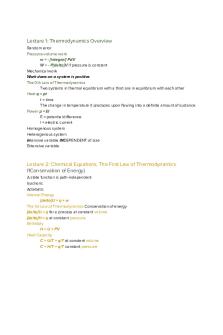
CHEM303 final exam review
- 4 Pages

Psychology Final Exam - Review
- 13 Pages
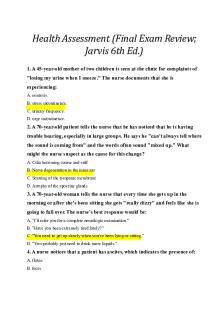
Jarvis Final Exam Review
- 12 Pages
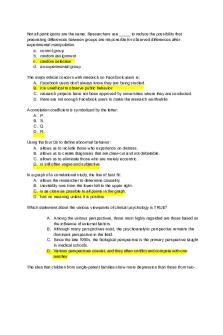
Final exam review
- 96 Pages
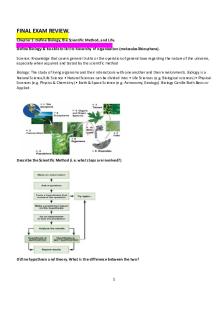
Final Exam Review
- 48 Pages
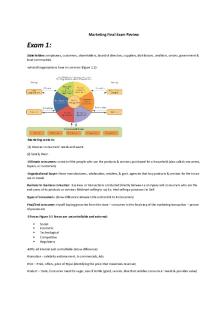
Marketing Final Exam Review
- 15 Pages
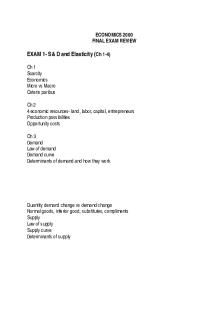
Final exam review
- 8 Pages
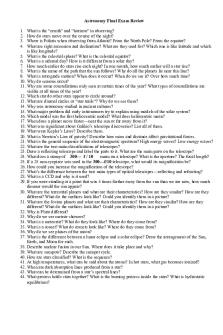
Astronomy Final Exam Review
- 2 Pages
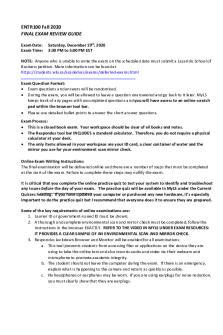
Final Exam Review Guide
- 4 Pages

Final exam review flsp4420
- 5 Pages
Popular Institutions
- Tinajero National High School - Annex
- Politeknik Caltex Riau
- Yokohama City University
- SGT University
- University of Al-Qadisiyah
- Divine Word College of Vigan
- Techniek College Rotterdam
- Universidade de Santiago
- Universiti Teknologi MARA Cawangan Johor Kampus Pasir Gudang
- Poltekkes Kemenkes Yogyakarta
- Baguio City National High School
- Colegio san marcos
- preparatoria uno
- Centro de Bachillerato Tecnológico Industrial y de Servicios No. 107
- Dalian Maritime University
- Quang Trung Secondary School
- Colegio Tecnológico en Informática
- Corporación Regional de Educación Superior
- Grupo CEDVA
- Dar Al Uloom University
- Centro de Estudios Preuniversitarios de la Universidad Nacional de Ingeniería
- 上智大学
- Aakash International School, Nuna Majara
- San Felipe Neri Catholic School
- Kang Chiao International School - New Taipei City
- Misamis Occidental National High School
- Institución Educativa Escuela Normal Juan Ladrilleros
- Kolehiyo ng Pantukan
- Batanes State College
- Instituto Continental
- Sekolah Menengah Kejuruan Kesehatan Kaltara (Tarakan)
- Colegio de La Inmaculada Concepcion - Cebu